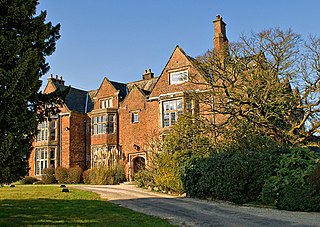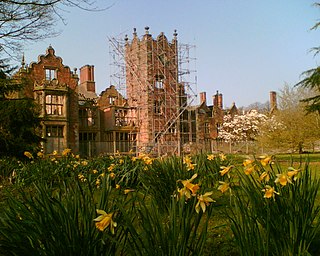
Thomas Littleton Powys, 4th Baron Lilford, was a British aristocrat and ornithologist.

Baron Lilford, of Lilford in the County of Northampton, is a title in the Peerage of Great Britain. It was created in 1797 for Thomas Powys, who had previously represented Northamptonshire in the House of Commons. His grandson, the third Baron, served as a Lord-in-waiting from 1837 to 1841 in the Whig administration of Lord Melbourne. He was succeeded by his son, the fourth Baron, an ornithologist. On the death of his younger son, the sixth Baron, in 1949, the line of the eldest son of the second Baron failed. The late Baron was succeeded by his second cousin twice removed, the seventh Baron. He was the great-great-grandson of the Hon. Robert Vernon Powys, second son of the second Baron. As of 2010, the title is held by his only son, the eighth Baron, who succeeded in 2005. The family seat from 1711 until the 1990s was Lilford Hall in Northamptonshire.
Henry Flitcroft was a major English architect in the second generation of Palladianism. He came from a simple background: his father was a labourer in the gardens at Hampton Court and he began as a joiner by trade. Working as a carpenter at Burlington House, he fell from a scaffold and broke his leg. While he was recuperating, the young Lord Burlington noticed his talent with the pencil, and by 1720 Flitcroft was Burlington's draughtsman and general architectural assistant, surveying at Westminster School for Burlington's dormitory, and superintending at the site at Tottenham House. Working life in the inner circle that was driving the new Palladian architecture was an education for Flitcroft.
Robert Browne was the founder of the Brownists, a common designation for early Separatists from the Church of England before 1620. In later life he was reconciled to the established church and became an Anglican priest.

Bretherton is a small village and civil parish in the Borough of Chorley, Lancashire, England, situated to the south west of Leyland and east of Tarleton. The population of the civil parish at the 2011 census was 669. Its name suggests pre-conquest origins and its early history was closely involved with the manor house Bank Hall and the families who lived there. Bretherton remained a rural community and today is largely residential with residents travelling to nearby towns for employment.
Lilford-cum-Wigsthorpe and Thorpe Achurch are a pair of adjacent civil parishes in the English county of Northamptonshire that share a single parish council.
Thomas Powys, 1st Baron Lilford was a British politician who sat in the House of Commons from 1774 to 1797 when he was raised to the peerage as Baron Lilford.
Thomas Atherton Powys, 3rd Baron Lilford, was a British peer and Whig politician.

Heskin is a small village and civil parish of the Borough of Chorley in Lancashire, England. According to the United Kingdom Census 2001 it has a population of 883 increasing to 898 at the 2011 Census.

Bank Hall is a Jacobean mansion in Bretherton, Lancashire, England. It is a Grade II* listed building and is at the centre of a private estate, surrounded by parkland. The hall was built on the site of an older house in 1608 by the Banastres who were lords of the manor. The hall was extended during the 18th and 19th centuries. Extensions were built for George Anthony Legh Keck in 1832–1833, to the design of the architect George Webster.

Colonel George Anthony Legh-Keck (1774–1860) was a British MP in the Georgian era who owned landed estates in Leicestershire and Lancashire.
The 303rd Station Hospital was a World War II hospital established in the grounds of Lilford Hall in Northamptonshire, England in September 1943 as a 750-bed hospital to provide medical attention to wounded men returning from combat. The hospital was expanded to a 1,500-bed hospital after D-day. The original commanding officer was Major Thompson followed by Colonels Smith, Abramson and Ragan. Seventy-five nurses had accommodations at the nearby Lilford Hall. The hospital was disbanded in May 1945.

Lilford Hall is a Grade I listed stately home in Northamptonshire in the United Kingdom. It was started in 1495 as a Tudor building, with a major Jacobean exterior extension added in 1635 and a Georgian interior adopted in the 1740s, having a 55,000 sq ft (5,100 m2) floor area. The 100-room house is located in the eastern part of the County of Northamptonshire, south of Oundle and north of Thrapston. A Grade I listed building is considered by the UK government as of outstanding architectural and historic interest.

Atherton Hall was a country house and estate in Atherton historically a part of Lancashire, England. The hall was built between 1723 and 1742 and demolished in 1824. In 1894 this part of Atherton was incorporated into Leigh. Christopher Saxton's map shows there was a medieval deer park here in the time of Elizabeth I.

Heskin Hall is a manor house in Heskin, Lancashire, England. Construction began on the present hall in 1545 making it a Tudor building which has been designated a Grade I listed building by Historic England.
George Vernon Powys, 7th Baron Lilford, was the son of Robert Horace Powys and Vera Grace Bryant. Born in 1931, he inherited the title of Baron Lilford in 1949 following the death of Stephen Powys, 6th Baron Lilford, until his death on 3 January 2005 at Paarl, South Africa.

Thomas Powys, 2nd Baron Lilford was a British peer. He was the son of Thomas Powys, 1st Baron Lilford and Mary Mann of Lilford Hall. He succeeded his father as Baron Lilford in 1800. He was educated at Eton College, St John's College, Cambridge and Lincoln's Inn (1794). He married Henrietta Maria Vernon Atherton of Atherton Hall, Leigh on 5 December 1797 at Penwortham, Lancashire and they had twelve children.
John Powys, 5th Baron Lilford was a British peer and cricketer
Stephen Powys, 6th Baron Lilford, was a British peer.

Bewsey Old Hall is a brick built, three storey, mainly Jacobean building, incorporating or reusing elements of a former medieval hall situated on the edge of Sankey Valley Park in Warrington, Cheshire. Bewsey Old Hall and estate was home to the Lords of Warrington from the thirteenth to the seventeenth century.









